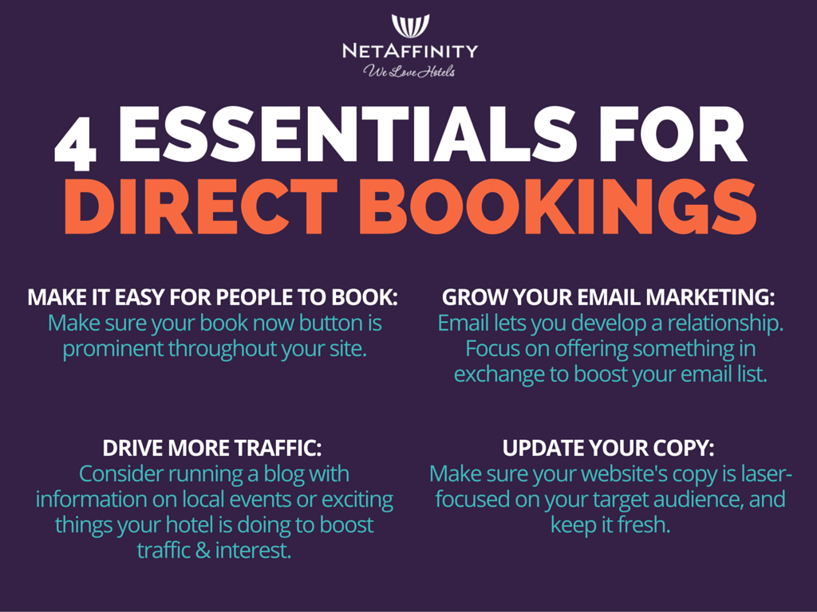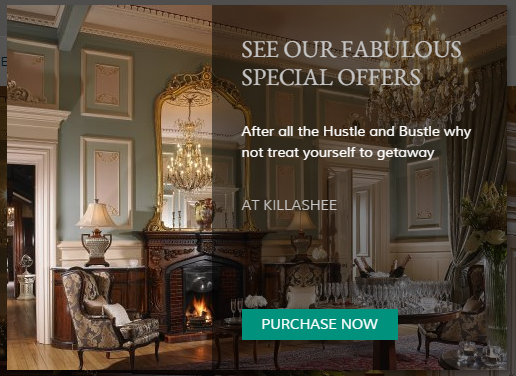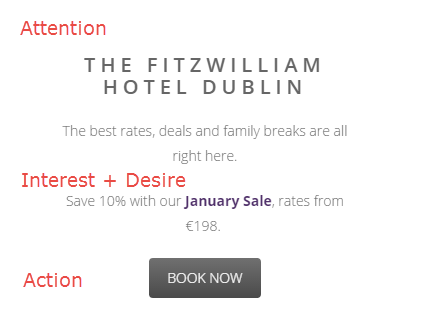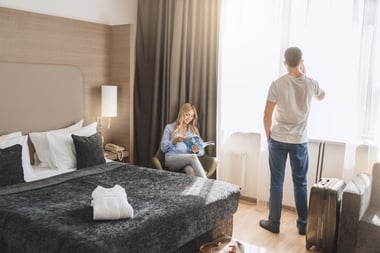A good book direct strategy is near the top of most hotelier’s list this year. Book direct campaigns from Marriott and Hilton are making headlines, and the focus of the industry as a whole is pivoting to look at booking direct as the way to grow profit margins.
Competition in the hospitality industry is at an all-time high, and it is only going to get fiercer. If hotels want to outdo sharing sites like Airbnb and, more importantly (at least for now), their competitor sets, they need to be doing everything they can to optimise their online presence and drive direct bookings.

We’ve created an in-depth list of 4 areas your book direct strategy needs to pay attention to, including links to guides and resources to help you get into the gritty details.
Check it out, and make sure your to-do list looks similar!
1. Make Booking Easy
Remember the last time you visited a restaurant’s website?
When you visit a restaurant’s website, you’re usually pretty hungry. It’s more than likely that you’re looking for the menu and hoping it looks as good as pizza does late at night. If you can’t find a menu, in this age of Yelp, MenuPages and a whole set of competitors with menus on their sites, you abandon all plans of visiting that restaurant. If you can’t find a restaurant’s menu online, someone (or several someones) aren’t doing their job.
Now put yourself in a potential hotel guest’s shoes. What do they want when they visit your website?
If they’ve done their research and are ready to book, they want to know:
- if there are rooms available on their preferred dates
- what they look like and which amenities they have
- how much it is going to cost them
Your job, once your potential guest has reached this stage, is simple: make it easy for them to find answers and book a room. The best way to do this is by making the bookings button conspicuous, or by placing the bookings form right on your home page.
A hotel that does a great job at driving attention to its bookings page throughout the site and not just on their homepage is the Killashee Hotel.
Even if you miss the popup, you can very swiftly find the bookings button or their offers page: they’re strategically placed on the home page. As soon as you visit the website, the popup above appears. If you click on the green ‘Purchase Now’ button, you are taken to a page where you can check out their offers and the price is clearly visible.
The booking button is prominent and accessible from every page on the site – and when it’s a long page, it’s in several places on the page.
When you have strategically place well-designed, attractive booking buttons, your website will be able to convert a higher-than-average amount of the traffic into direct bookings and heads in beds. How is your hotel website’s booking CTA looking? If it’s not prominent, get it to the point where it passes the squint test on all your major pages right away!
2. Focus Your Copy
One of the biggest copywriting blunders hotels make while creating content for their hotel websites is trying to write for everyone. Their copy is aimed to please the Airbnb users, the young couples, the business travelers and everyone else.
However, no matter how hard you try, you can’t please everyone – and if you try, you’ll end up pleasing no one.
and if you try, you’ll end up pleasing no one.
Your copy should be laser focused on targeting just one or two types of guests. It’s up to you to do the research to figure out who your target audience is.
Some great ways to focus your process and make sure the data is backing up your findings is to create empathy maps and guest personas. Take it all into account: your analytics data, booking patterns over your hotel’s history, and your first-hand knowledge of your guests.
You want to position your hotel as a unique offering, with comforts and conveniences they can’t find elsewhere. Are you a luxury hotel? A boutique? Present your hotel in its best, most unique light. It’s not for people looking for a home. It’s for people looking for something better, and it is your job to project that experience in the copy.
You can learn more about positioning in this article. It talks about how Amazon positioned the Kindle Fire in order to co-exist with iPad, and in the process succeeded in the place of tablets created by brands like Samsung and Lenovo.
Car brands like Bentley use positioning too. They use it to stand out from regular cars and get their audience to splash out hundreds and thousands on what is essentially just another way to get around.
The Fitzwilliam Hotel‘s website has a great example of copy done well:
The hotel’s homepage and inside pages are filled with well-written copy that detail the comforts and features the rooms offer, the food & drinks available at their restaurants, and how you can have fun at their beauty salon or their gym – emphasizing benefits, not features. They also mention their central location in a call to the benefits outside their hotel’s doors. Ideally, the Fitzwilliam should be highlighting features many of their competitors either don’t have or aren’t presenting as well as them.
Do as much research as you can about your target audience and your competitor set, and then write copy that focuses on attracting potential hotel guests who are looking for a rich experience.
If you ever get stuck with writing the copy for your hotel, try following the AIDA model. It stands for attention, interest, desire and action. Create attention with an attractive headline, generate interest and desire by listing the benefits, and get people to take action with a call-to-action. It’s that simple.
Good copywriting doesn’t need to be hard. For a detailed overview on AIDA and other copywriting formulas, read this post by Joanna Wiebe.
3. Hone Your Email Strategy
Not all the potential hotel guests who visit your website are interested in making a booking right away. Some of them will be checking your website as they plan a trip months away, some are comparing prices, a few will be curious about an offer you have, and so on. How can you get these potential guests to make a direct booking at your hotel?
One answer is to persuade them to give you their email address. Once you have their email address, you can regularly email them your latest offers, news and other developments, and drive plenty of direct bookings.
Here’s a simple email marketing strategy:
a) Offer something in exchange:
An uncomplicated way to get more potential hotel guests to sign up with their email address is by offering them something in exchange. One great offer to make is a coupon or a voucher – get potential guests to take part in a contest for a free meal, free stay or a discount in exchange for their email address.
b) Place opt-in forms:
When you’re running a well-designed offer, with great copy and a strong incentive to book (like a limited-time offer or an irresistible discount), you should promote it by placing opt-in forms on various places of your website. These opt-in forms should tell people what the offer is for. Make it clear that all they need to do is enter their email address.
You can even create a landing page that is solely dedicated to promoting the offer or the voucher.
c) Set up autoresponders:
Using your email marketing software, you should set up a series of automated emails that are triggered once the person signs up. Providers like Mailchimp will have automatic signup confirmation and welcome emails, which you can customize any way you like.
The first email they get should welcome them and send them the details of the offer they subscribed for. The second email should be sent the next day, and can be your most recent newsletter or an additional welcome email.
In this way you should set up several emails over the course of weeks that help you stay in touch with your subscribers. The aim is to forge a trustworthy relationship so that when you email them an offer, they will book a room.
This strategy leads to more profitable bookings than ones you get immediately through your website or a third party. You can get your hotel guests to book rooms again and again, increasing the lifetime value of the guest. Build a relationship through your emails – make sure you’re warm and personable, as well as being professional.
The Fitzwilliam Hotel have strategically placed a sign-up form at the bottom of the homepage. When scrolling down the page, people browse through the rooms and restaurants and are then brought to the sign-up form. It informs them that they will be the first to hear about special offers. This offers them a feeling of exclusivity and belonging. They also mention that they will send them vouchers for meals and treatments. This is the bribe.
Once they get their email address, they have the opportunity to build a strong relationship.
4. Drive More Traffic
Once you have followed the above tips and created your wonderful campaign with its sparkling copy, booking forms and a well-planned email marketing strategy, there is only one thing left to do to complete your hotel marketing funnel. Drive traffic.
An inexpensive way to drive traffic – and direct bookings – is by running a blog as part of your hotel site. The Four Seasons has taken this concept to the extreme, setting up a sophisticated magazine site with pieces that each subtly bring the focus back to various Four Seasons properties. They share the articles on Pinterest, Twitter and their other social channels.
Yours doesn’t need to be like that, but a few pieces a month about local events, sites or happenings in your hotel will do a lot to draw interest.
Here’s a quick guide to help you get started:
a) Set up a blog
When you want a blog, WordPress is one of the best and easiest platforms to use. You have features like plugins that make it very easy to use. You can also use themes and templates to get it to look very professional. For best results, hire a good hotel blog designer. The designer should be able to install an SEO and social media friendly theme, and tweak it as time goes on to get better results.
b) Publish quality posts
After you set up the blog, it’s time to start writing and publishing posts. What should they be about? Try writing about interesting local events, the thought behind the architecture or design of your hotel, things to do nearby, and similar things – you can even throw in articles about local traditions and recipes if they’re interesting!
You should either publish short posts (around 700 words) once a week or so, or long posts (over 2,000 words) a few times a month. If you’ve got the material, it’s better to go for the second option, as longer posts perform better on social media and search engines. It also gives you some slack so you’re not always trying to produce new content. You can spend the rest of the time promoting your post on social media and building backlinks. For tips on how to write posts that get you hotel guests, check out this post.
c) Integrate into your Book Direct strategy
Once you start publishing posts and promoting them regularly, you will see an increase in traffic on your blog and your hotel website. It’s time to integrate that traffic into your book direct strategy. You should make the most of this traffic by displaying adverts on your blog that promote the services and offers at your hotel. Make sure the adverts lead to a booking form or an opt-in form to help convert ‘lookers’ into ‘bookers’ and email subscribers.
Warning: Remember that getting results from blogging will take at least 3 to 6 months. While you wait for your blog to grow, and even after it’s a solid driver of bookings, you should invest a good chunk of your budget in running marketing campaigns.
The most uncomplicated way to do this is to use Google Adwords, Facebook ads and ads on other social platforms.
Here’s our 10-step guide to creating a digital marketing campaign for your hotel.
You can also advertise your hotel on other travel, food, and hospitality blogs to drive direct bookings. Consider contacting blog owners to find out how much they charge for displaying adverts. This can sometimes cost a lot less than running ads on Facebook and Google.
To ensure you track results correctly you should also invest in a good analytics tool – Google Analytics is free and pretty comprehensive. If you want something a bit more in-depth, consider Hubspot or a similar tool.
Well-placed booking forms, persuasive copy, an email marketing strategy and traffic attracted through blogging and ads are four of the most essential marketing activities for driving direct bookings for your hotels. Get them right and your hotel will turn into a booking machine.
Are there any other essential marketing activities required for your hotel’s book direct strategy? Please leave your comments below.







